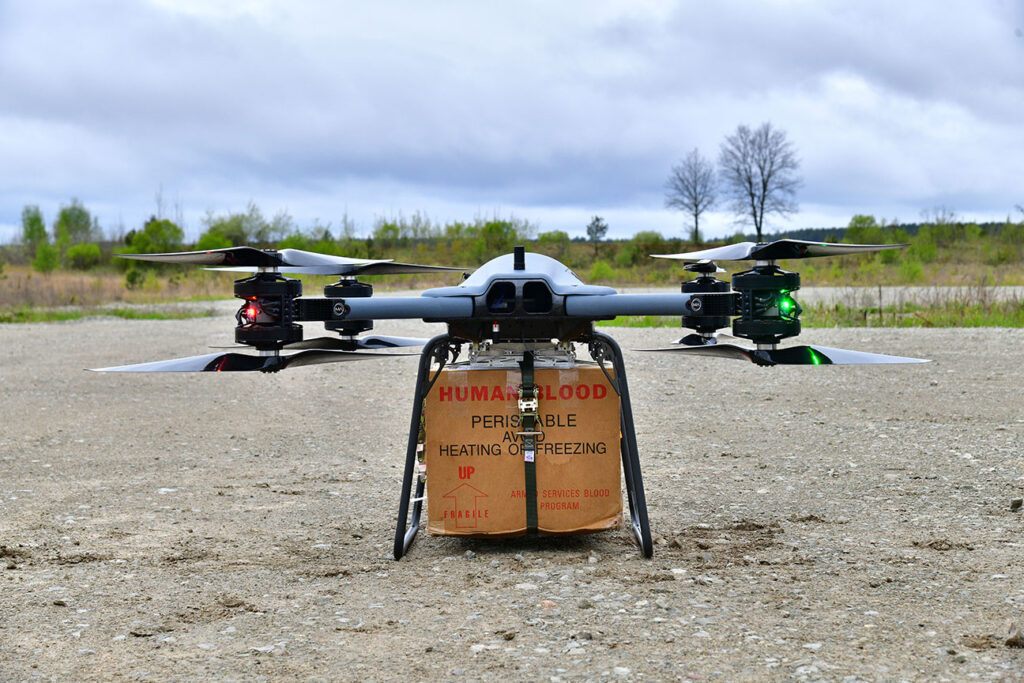U.S. Army paratroopers with the 173rd Airborne Brigade and multinational medical teams tested drones to transport blood as part of Swift Response 2025 at Camp Adrian Rohn near Pabradė, Lithuania, on May 15, 2025. ELENA BALADELLI/U.S. ARMY
THE WATCH STAFF
In combat, seconds count, and a pint of blood can mean the difference between life and death. With that in mind, the United States Army has begun testing drones to deliver blood supplies to the battlefield. At Swift Response 2025, a multinational exercise held by NATO allies and partners in the High North and Baltic region, medics with the U.S. Army’s 173rd Airborne Brigade used unmanned aerial vehicles (UAV) to safely slash the amount of time it took to get blood supplies to combat areas. The hospital exercise took place May 15 at the Pabradė Training Area, Lithuania.
For decades, the Army has relied on helicopters or ground vehicles to get supplies, including blood, to medics treating Soldiers on the front lines. During Swift Response that meant moving blood supplies 3 to 4 kilometers, which could take 20 to 30 minutes in a field ambulance. The UAVs took about four minutes. “The difference is someone dying and someone not, because four minutes is substantially faster than 20 or 30,” 1st Sgt. Cyril Clayton, a senior medic with the 173rd Brigade, told Task & Purpose, a military news website. “As far as risk to the force goes, we’ve cut it from probably five to two.”
Using UAVs to deliver blood not only was much faster, it got the supplies closer to the medics more often than a ground vehicle or helicopter could have, depending on the terrain and road access. It also protected a helicopter or ambulance crew from potential enemy fire and accidents.
“Aerial resupply of blood is pretty cool for us,” Capt. Jessica Knoll, commander of the 173rd’s Charlie “Lifeline” Company, 173rd Brigade Support Battalion, said in a U.S. Army article. “One big initiative we’re working on is getting whole blood as far forward as possible. Having drone capability means we’re not risking Soldiers driving into hostile areas just to deliver blood. A drone — not to say it’s expendable — but it’s more expendable than a Soldier’s life.”
The next step for UAVs may be using them to transport injured patients from the front lines to field hospitals, Maj. David Hourani, a surgeon for the 173rd, told Task & Purpose. “The force of drone movement on human tissues is about as good as we can do prior to actual humans,” he said.
Army medics use a range of blood supplies — including whole blood, red cells, platelets and plasma — and all must be kept on ice. At the Saber Junction exercise in Germany in September 2024, medics parachuted in with blood supplies, but they learned that method was constrained by the need to maintain the temperature with ice.
“There’s definitely a limited shelf life on how long we can keep units,” Clayton told Task & Purpose. “The requirements for ice are heavy, and anytime you’re going to jump something under canopy, that’s a concern, so they need rapid ability to either re-cool or have access to ice, which are both tall orders.”
Also, the g-forces and impacts of parachuting can damage blood cells’ outer membrane. “Any force outside of normal parameters could potentially damage those cells … and then they’re no longer viable for resuscitation,” Clayton said.
The 173rd tested Class II UAVs, which weigh 9.5 to 25 kilograms and can fly as high as 1.07 kilometers; the TRV-150 cargo drone, which is about 2.6 meters long and 1.8 meters wide, weighs around 57 kilograms, and can carry 68 kilograms of cargo; and the FlyingBasket drone, which is about 1.5 meters wide, weighs 68 kilograms and can carry up to 100 kilograms, Task & Purpose reported.

